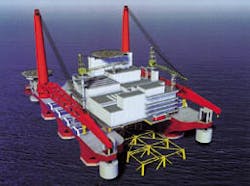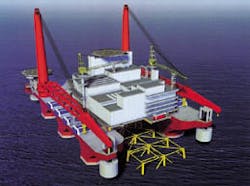Bringing tension-leg techniques to bear on platform removal
Specialized deballasting for semisubmersible
Once the topsides weight has been transferred to the vessel and the topsides cut free from the jacket, Master Mind pulls anchor and prepares to head for shore.A new heavy-lift vessel concept aimed primarily at the platform removal market has been developed by Master Marine. Tension-leg mooring techniques are used to ensure the safe transfer of the load onto the deck of the vessel at sea.
The concept has been developed by Master Marine, whose senior partner, Per Johansson, has extensive experience in heavy-lift marine operations in the Norwegian sector. Projects in which he has been involved include the mating of the Gullfaks C deck and concrete gravity base. The deck, at 52,000 tons, is the heaviest load ever transported by barge.
Johansson previously worked at Neptun Heavy Lift, where he played a leading role in the mating of the 37,100-ton Hibernia topsides and base and was responsible for developing the cradle-lift concept for lifting the Brent Spar hull and enabling it to be cut into slices for re-use as a quay foundation.
At Master Marine, he is keen to bring the expertise developed in such marine operations to bear on the problems of platform abandonment. The big problem to be overcome is the difference in conditions between the sheltered inshore waters, where platform mating takes place, and the open sea, in which platforms are located.
"We want to take the inshore mating technique offshore," says Johansson. "But first we had to get round the fact that if you use barges with a big water-plane area, you will have problems with dynamic forces."
The solution was to develop a vessel which uses the principles of tension-leg mooring to provide a stable platform on which to land the deck which is to be removed.
Named Master Mind, the semisubmersible vessel is outfitted with a tie-down system using suction anchors as a bottom foundation. On arriving at the platform to be removed, the vessel is ballasted down, maneuvered under the platform deck and moored in place using suction anchors, which are 11 meters in diameter and have a 3,000-ton vertical load capacity.
Deballasting process
Once the anchors are installed, the vessel is deballasted. At the same time, the steel ropes attached to the suction anchors - equivalent to the tethers of a tension-leg platform - are pre-tensioned in order to ensure no slack occurs in them when a wave trough passes. As the vessel goes down in a trough, the hydraulic jacks which control the ropes move upwards by the same distance and lock when the vessel is at its lowest position, acting as non-return valve. When pretensioning is completed, roll, pitch and heave motions are eliminated, Johansson says.Deballasting can then continue in a controlled and stable fashion until the vessel is taking the weight of the deck. Once the deck has been cut free from the jacket, a quick-release mechanism in the jacks ensures clearance is swiftly achieved between the bottom of the deck and the top of the jacket in order to avoid slamming.
During load transfer the vessel acts like a tension-leg platform. "This is the really unique aspect," says Johansson. "The technology is known, but we are using it in a new way."
Independent removal
Another unique feature, he stresses, is the fact that Master Mind has no need of assistance from other vessels when working offshore. It carries, installs and retrieves all the equipment it requires, and is self-propelled. While other methods of retrieving whole topsides are also under development, Johansson claims that Master Mind's ability to work on its own implies significant cost-savings and safer operations.The vessel has two pontoons, each 117.7 meters long, between which a wing-shaped profile is located towards the bow. The profile increases the strength of the structure and dampens the effect of wave motions on the vessel.
On each pontoon there are three 17-meter high columns which support the U-shaped deck. This consists of two side-bodies connected by a transverse body at the front of the vessel. The upper hull has an overall length of 127.7 meters and breadth of 86 meters. The width of the moonpool between the side bodies is 43 meters.
Installed transversely along each side-body are eight supporting beams, on which the load rests. These can be transversely retracted during positioning of the vessel under the topsides, or advanced over the moonpool to support the load. They also can be relocated along the side body to match the spacing of the legs on the topsides. Equalizing jacks are housed on top of each beam to ensure correct load distribution and avoid overstress in any one area.
The main ballast tanks are located in the upper hull. Butterfly valves are used to increase the deballasting capacity and shorten the period of pre-tensioning and load transfer.
The propulsion system uses eight Voith propellers, two at each corner of the vessel. These also provide the dynamic positioning capability, and give a quicker response when the vessel is maneuvering around the platform than the thrusters conventionally used in offshore craft.
At the front of the vessel are located two accommodation units, one on either side, with a total of 140 beds. For platform removal projects, Johansson foresees a crew complement of around 110. The bridge/operations control center is located on top of one unit and the helideck on the other. On either side body is installed a pedestal crane with 1,200 tons lifting capacity.
Master Mind has been designed to carry topside structures of up to 20,000 tons weight. It can undertake load transfer operations in up to 3 meters significant wave height, is extremely stable in transport mode, and can carry 16,000-ton loads in a 100-year storm.
Lifting jackets
With the aid of the cranes, jackets can also be lifted and slung from the beams for transport. Because of the constraint of the moonpool width, larger jackets might be cut and lifted in several pieces. Strand jacks could also be used for lifting a jacket in the vessel's moonpool area if the weight exceeded the capacity of the cranes. Lifts of up to 20,000 tons are possible with a strand jack system.A number of patents have now been applied for, principally relating to the novel application of tension-leg technology, and Master Marine is ready to start marketing the vessel.
The Norwegian Geotechnical Institute was employed for the conceptual design of the suction anchors and calculation of their vertical holding capacity, Structural Engineering for development of design and drawings, and Caran Dynam ics for dynamic motion analysis of the vessel.
"The next step will be to get the main scantling approval, which we will undertake this spring," says Johansson. "We'll then be in a position to get a yard to build the vessel." The construction period for the vessel is estimated at about 20 months by a large European shipyard.
Offshore decommissioning projects will require a certain size of organization to provide for all the disciplines needed for the performance of a project. As Master Marine is a small company, Johansson says the future involves the formation of a Norwegian-UK consortium, probably involving a large offshore contractor, a shipping company, small engineering companies, and investors.
In addition to abandonment operations, Master Mind has the versatility to undertake other roles. The most obvious is topsides installation, involving a reversal of the removal procedures. It could be also used for pipelay, for which it could be fitted with a 10,000-ton reel. The crane capacity would enable it to perform offshore construction and lifting work, both above the surface and subsea, and it could also be outfitted to undertake well intervention. Master Marine will present the Master Mind concept on the European Union's stand at OTC.
Copyright 1999 Oil & Gas Journal. All Rights Reserved.

